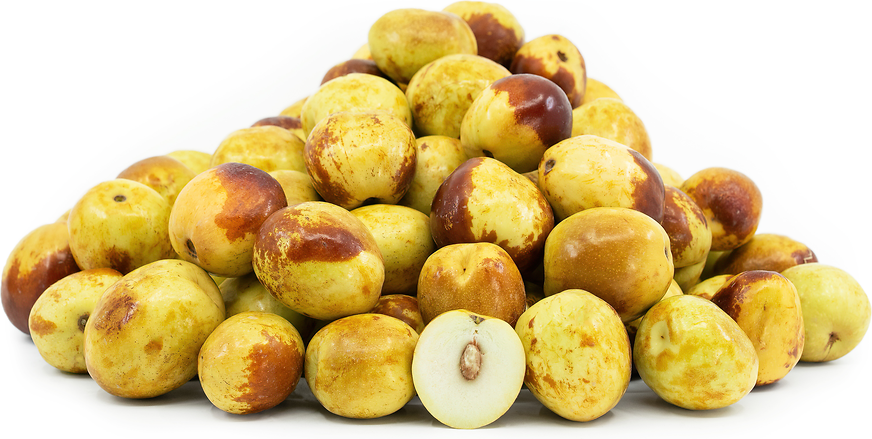


Li Jujube
Estimated Inventory, lb : 0
Description/Taste
Li jujubes are a larger variety, averaging 3 to 5 centimeters in diameter, and have a round to ovate shape. The skin is firm, smooth, and thin, transitioning from green when immature to yellow-green, red-brown, to mahogany when mature. Li jujubes are considered edible in their yellow-green phase, and as the fruit matures, the skin may bear variegated hues of green, yellow, and brown depending on the degree of ripeness. Underneath the surface, the flesh is crisp, grainy, airy, and semi-aqueous with a snap-like quality similar to an apple. There is also a small pit found in the center of the pale green to white flesh. Li jujubes have a high sugar content, contributing to the fruit’s very sweet taste, and also contain lower amounts of acidity to create subtle tangy notes.
Seasons/Availability
Li jujubes are available in the late summer through fall.
Current Facts
Li jujubes, botanically classified as Ziziphus jujube, are large, sweet fruits belonging to the Rhamnaceae family. Jujubes are ancient fruits native to China, traditionally grown to maturity and consumed dried when they have a date-like consistency. As the cultivation of the fruits increased over time, many new varieties were created to diversify the jujube market, and cultivars were developed to be eaten fresh. Li jujubes are considered to be one of the largest jujubes available in commercial markets. The round fruits were specifically developed for fresh eating and are favored for their thin, crisp skin and sweet flavor. Outside of China, Li jujubes are also one of the top cultivars grown in the United States. Li jujube trees are a hardy, drought and cold tolerant variety, with an easy-to-grow, prolific nature. American consumers highly value jujubes for fresh eating instead of dried uses, and the trees can be found through specialty growers and home garden enthusiasts.
Nutritional Value
Li jujubes are an excellent source of minerals, including potassium to regulate fluid levels, zinc to fight off viruses, and phosphorus to help grow bones. The fruits are also a good source of fiber, which helps stimulate the digestive tract, and vitamin C, an antioxidant that strengthens the immune system and contributes anti-inflammatory properties.
Applications
Li jujubes are best suited for raw applications as their large size, sweet flesh, and thin skin is showcased when consumed fresh, out-of-hand. The flesh can be eaten as a snack or fresh dessert, or it can be juiced into a refreshing beverage. In addition to fresh eating, Li jujubes can be cooked into honey, jams, and syrups, made into a paste for fillings in cakes and pastries, candied, or incorporated into stews, porridges, and rice dishes. They are also occasionally dried for teas, smoked, or fermented into wine. Whole Li jujubes can be stored in a sealed container in the refrigerator for 2 to 4 weeks when fresh. Dried jujubes will keep 6 to 12 months when stored in a cool, dry place.
Ethnic/Cultural Info
Across the Southwestern United States, jujube trees are seen growing along railroad tracks in peculiar places. The trees date back to the 19th and early 20th centuries and were sown from scattered jujube seeds, discarded from railroad workers building the railways. It is believed that over twenty thousand Chinese immigrants came to the United States to help construct the Transcontinental Railroad. While working on the railroad, the workers brought their favorite foods from China, including jujubes, and would consume the sweet fruits to help maintain energy levels. Jujubes were believed in traditional Chinese medicine to help boost stamina, regulate the liver, and balance the body’s overall health. Once the jujubes were consumed, the seeds would be tossed alongside the work site, and over time, a few of the seeds grew into mature trees. Today the jujube trees are still found growing near the railway throughout Arizona, Texas, and New Mexico, bearing fruit each year and are considered to be some of the first jujube trees found in the United States.
Geography/History
Jujubes are native to China, where they have been growing for over 4,000 years. The small fruits were later transported along the silk road and introduced into the rest of Asia, the Middle East, and Europe sometime around 380 CE. Jujubes have been extensively cultivated in China, selected for improved growth characteristics and flavor, and it is believed that there are over 400 varieties of jujubes in existence. In 1908, agricultural explorer Frank Meyers, in partnership with the USDA, visited China and gathered 67 samples jujube varieties, including Li jujubes from the Shanxi province. All 67 varieties were first planted at the Plant Introduction Station in Chico, California, and were eventually distributed among other USDA stations, including Florida, New Mexico, Oklahoma, Texas, and Georgia. In 1926, after trialing the cultivars, the USDA recommended four varieties, including Li jujubes, for cultivation in the United States. In the present day, Li jujubes are still one of the top commercially grown varieties within the United States. The variety can also be found in Asia, mainly in China, Europe, the Middle East, and Australia.

Recipe Ideas
Recipes that include Li Jujube. One



